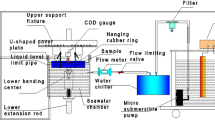Abstract
HY-80, HY-130, 17-4 PH and Ti 6AI 4V compared in large-scale, welded structures
Similar content being viewed by others
References
Beach, J. E. et al., “A Large-Scale Fatigue Evaluation of Hydrofoil-Foil Structures,” SNAME/AIAA Advanced Marine Vehicles Conference (17-19 Apr 1978).
MIL-STD-0022B (SHIPS) 8 May 1969, “Military Standard Welded Joint Design”.
Starr, G. A., “Titanium for High Speed Hydrofoils—A Cost-Value Study,” LTV Vought Aeronautics, Feb. 1965.
Palmgren, A., “Die Lebensdauer von Kugellagern,” DTI-Z, Vol. 68 (1924).
Miner, M. A., “Cumulative Damage in Fatigue,” Journal of Applied Mechanics, Vol. 12 (1945).
Richards, C. W., Chapter 9, Engineering Materials Science, Wadsworth Publishing Company, San Francisco (1967).
Marchica, N. V. and Ichter, L. L., “Fatigue and Crack-Growth Analyses of Hydrofoil Box Beams, DTNSRDC Report 77-0097, Oct. 1977.
“Structural Steel Design,” Edited by L. Tall, Ronald Press Company, New York (1974).
Forman, et. al., “Numerical Analysis of Crack Propagation in Cyclically Loaded Structures,” J. of Basic Engr., Trans. ASME Vol. 89, Series D, Sept. 1967.
Engle, R. M., “CRACKS II User’s Manual” Structures Department, Air Force Flight Dynamics Laboratory, Dayton, Ohio, AFFDL-RM-74-173 (1974).
Additional information
JEFF BEACH is a Senior Project Engineer in the Structures Department of the David W. Taylor Naval Ship Research and Development Center, Bethesda, Maryland, where he has been employed since 1969. He received a B.S. and M.S. in Aerospace Engineering from the University of Maryland.
NICK MARCHICA is currently employed as a project manager with the Consumer Product Safety Commission. He was formerly employed as a structural engineer at the David W. Taylor Naval Ship Research and Development Center, Bethesda, Maryland. He received a B.S. CE. from Lafayette College in 1972 and a M.S. C.E. from Lehigh University in 1974.
LARRY ICHTER is currently employed in the Bridge Department at Hayes, Seay, Mattern and Mattern in Roanoke, Virginia. Formerly, he was employed as a structural engineer in the area of fatigue crack growth at the David W. Taylor Naval Ship Research and Development Center, Bethesda, Maryland. He received a B.S. and M.S. in Civil Engineering from the University of Virginia.
Rights and permissions
About this article
Cite this article
Beach, J.E., Marchica, N.V. & Ichter, L.L. A fatigue comparison of high strength steel, stainless steel and titanium in a simulated ocean environment. JOM 30, 15–20 (1978). https://doi.org/10.1007/BF03354367
Published:
Issue Date:
DOI: https://doi.org/10.1007/BF03354367




